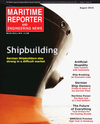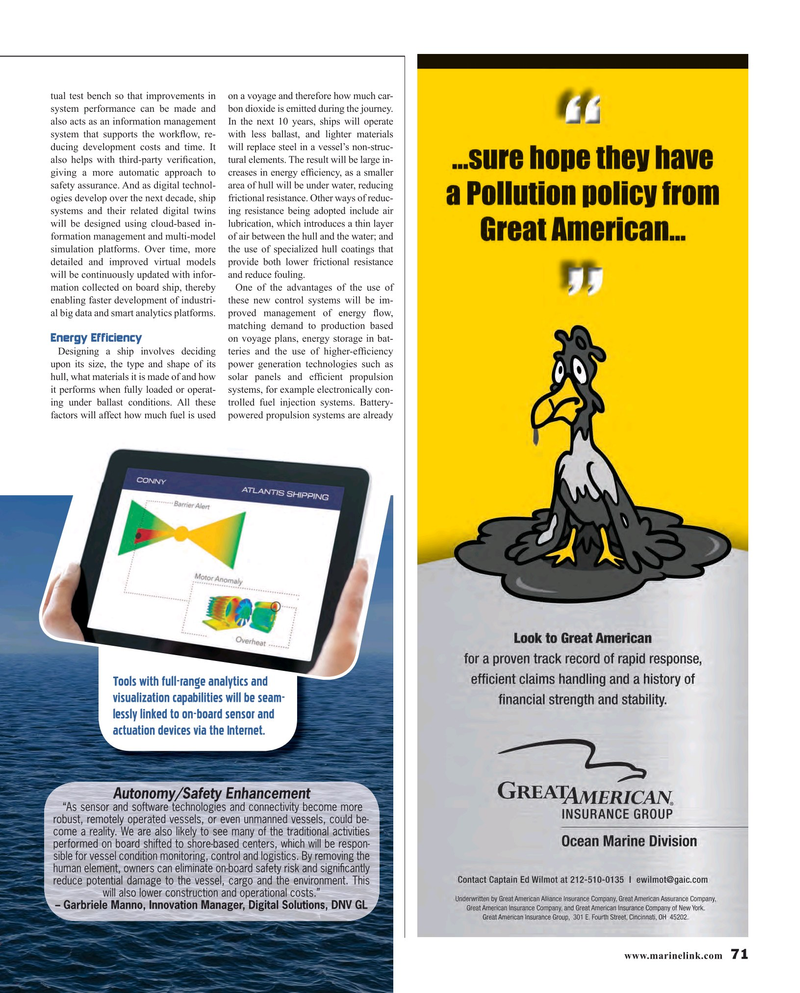
Page 71: of Maritime Reporter Magazine (August 2016)
The Shipyard Edition
Read this page in Pdf, Flash or Html5 edition of August 2016 Maritime Reporter Magazine
tual test bench so that improvements in on a voyage and therefore how much car- system performance can be made and bon dioxide is emitted during the journey. also acts as an information management In the next 10 years, ships will operate system that supports the work? ow, re- with less ballast, and lighter materials ducing development costs and time. It will replace steel in a vessel’s non-struc- also helps with third-party veri? cation, tural elements. The result will be large in- giving a more automatic approach to creases in energy ef? ciency, as a smaller safety assurance. And as digital technol- area of hull will be under water, reducing ogies develop over the next decade, ship frictional resistance. Other ways of reduc- systems and their related digital twins ing resistance being adopted include air will be designed using cloud-based in- lubrication, which introduces a thin layer formation management and multi-model of air between the hull and the water; and simulation platforms. Over time, more the use of specialized hull coatings that detailed and improved virtual models provide both lower frictional resistance will be continuously updated with infor- and reduce fouling.
mation collected on board ship, thereby One of the advantages of the use of enabling faster development of industri- these new control systems will be im- al big data and smart analytics platforms. proved management of energy ? ow, matching demand to production based
Energy Efficiency on voyage plans, energy storage in bat-
Designing a ship involves deciding teries and the use of higher-ef? ciency upon its size, the type and shape of its power generation technologies such as hull, what materials it is made of and how solar panels and ef? cient propulsion it performs when fully loaded or operat- systems, for example electronically con- ing under ballast conditions. All these trolled fuel injection systems. Battery- factors will affect how much fuel is used powered propulsion systems are already
Tools with full-range analytics and visualization capabilities will be seam- lessly linked to on-board sensor and actuation devices via the Internet.
Autonomy/Safety Enhancement “As sensor and software technologies and connectivity become more robust, remotely operated vessels, or even unmanned vessels, could be- come a reality. We are also likely to see many of the traditional activities performed on board shifted to shore-based centers, which will be respon- sible for vessel condition monitoring, control and logistics. By removing the human element, owners can eliminate on-board safety risk and signi? cantly reduce potential damage to the vessel, cargo and the environment. This will also lower construction and operational costs.” – Garbriele Manno, Innovation Manager, Digital Solutions, DNV GL www.marinelink.com 71
MR #8 (66-73).indd 71 8/1/2016 3:47:07 PM

 70
70

 72
72
